Design and Optimization Strategies for Flexible Quasi-Solid-State Thermo-Electrochemical Cells
Abstract
:1. Introduction
2. Wearable Thermo-Electrochemical Cells
2.1. Thermo-Electrochemical Cells
2.1.1. The Seebeck Coefficient of TECs
2.1.2. Performance Index of TECs
2.2. Electrochemical Thermogalvanic Effect
2.3. Quasi-Solid-State Electrolyte
2.4. Electrode
3. Device Integration and Applications
- Optimizing thermoelectric materials: materials with high Seebeck coefficients and low thermal conductivity should be selected. A high Seebeck coefficient can increase the thermoelectric conversion efficiency, while a low thermal conductivity can reduce heat dissipation.
- Increasing the temperature gradient: the thermoelectric conversion efficiency is directly proportional to the temperature gradient. It can improve the temperature gradient by increasing the temperature of the high-temperature heat source or decreasing the temperature of the low-temperature heat source, thus improving the thermoelectric conversion efficiency.
- Reducing heat dissipation: optimization of the insulating material and structural design of the thermocells can reduce heat dissipation and improve the thermoelectric conversion efficiency.
- Cascade thermoelectric module: multiple thermoelectric modules are cascaded together to improve the thermoelectric conversion efficiency. In the cascade thermoelectric module, the waste heat from the high-temperature heat source can be further utilized, thus improving the energy conversion efficiency of the whole system [2,19,27,78].
- Current distribution: in Π-type connections, the current distribution across the thermoelectric elements is more uniform, with each element carrying the same current. However, in Z-type connections, the current is distributed across different elements due to their series connection, resulting in an uneven current distribution that affects efficiency.
- Thermal resistance: in Π-type connections, each thermoelectric element exhibits the same thermal resistance due to their parallel connection, thereby reducing the overall thermal resistance. In contrast, in Z-type connections, the thermal resistance increases due to the series connection of the thermoelectric elements, hence affecting their efficiency.
- Voltage distribution: in Π-type connections, the voltage distribution is more uniform, with each element having the same voltage. However, in Z-type connections, the voltage is distributed across different elements due to their series connection, leading to an uneven voltage distribution that affects the efficiency.
4. Summary and Outlook
Author Contributions
Funding
Acknowledgments
Conflicts of Interest
References
- Burmistrov, I.; Khanna, R.; Gorshkov, N.; Kiselev, N.; Artyukhov, D.; Boychenko, E.; Yudin, A.; Konyukhov, Y.; Kravchenko, M.; Gorokhovsky, A.; et al. Advances in thermo-electrochemical (tec) cell performances for harvesting low-grade heat energy: A review. Sustainability 2022, 14, 9483. [Google Scholar] [CrossRef]
- Huo, B.; Guo, C.-Y. Advances in thermoelectric composites consisting of conductive polymers and fillers with different architectures. Molecules 2022, 27, 6932. [Google Scholar] [CrossRef] [PubMed]
- Wu, X.; Luo, Q.; Yin, S.; Lu, W.; He, H.; Guo, C.-Y. Organic/inorganic thermoelectric composites electrochemical synthesis, properties, and applications. J. Mater. Sci. 2021, 56, 19311–19328. [Google Scholar] [CrossRef]
- Zhang, Y.; Wang, W.; Zhang, F.; Dai, K.; Li, C.; Fan, Y.; Chen, G.; Zheng, Q. Soft organic thermoelectric materials: Principles, current state of the art and applications. Small 2022, 18, 2104922. [Google Scholar] [CrossRef] [PubMed]
- Sootsman, J.R.; Chung, D.Y.; Kanatzidis, M.G. New and old concepts in thermoelectric materials. Angew. Chem. Int. Ed. 2009, 48, 8616–8639. [Google Scholar] [CrossRef]
- Shi, X.; He, J. Thermopower and harvesting heat. Science 2021, 371, 343–344. [Google Scholar] [CrossRef]
- Shi, X.; Chen, H.; Hao, F.; Liu, R.; Wang, T.; Qiu, P.; Burkhardt, U.; Grin, Y.; Chen, L. Room-temperature ductile inorganic semiconductor. Nat. Mater. 2018, 17, 421–426. [Google Scholar] [CrossRef]
- Li, T.; Zhang, X.; Lacey, S.D.; Mi, R.; Zhao, X.; Jiang, F.; Song, J.; Liu, Z.; Chen, G.; Dai, J.; et al. Cellulose ionic conductors with high differential thermal voltage for low-grade heat harvesting. Nat. Mater. 2019, 18, 608–613. [Google Scholar] [CrossRef]
- He, X.; Cheng, H.; Yue, S.; Ouyang, J. Quasi-solid state nanoparticle/(ionic liquid) gels with significantly high ionic thermoelectric properties. J. Mater. Chem. A 2020, 8, 10813–10821. [Google Scholar] [CrossRef]
- Wu, X.; Gao, N.; Jia, H.; Wang, Y. Thermoelectric converters based on ionic conductors. Chem. Asian J. 2021, 16, 129–141. [Google Scholar] [CrossRef]
- Liu, W.; Qian, X.; Han, C.-G.; Li, Q.; Chen, G. Ionic thermoelectric materials for near ambient temperature energy harvesting. Appl. Phys. Lett. 2021, 118, 020501. [Google Scholar] [CrossRef]
- Chi, C.; Liu, G.; An, M.; Zhang, Y.; Song, D.; Qi, X.; Zhao, C.; Wang, Z.; Du, Y.; Lin, Z.; et al. Reversible bipolar thermopower of ionic thermoelectric polymer composite for cyclic energy generation. Nat. Commun. 2023, 14, 306. [Google Scholar] [CrossRef]
- Yue, Q.; Gao, T.; Wang, Y.; Meng, Y.; Li, X.; Yuan, H.; Xiao, D. A novel gel thermoelectric chemical cell for harvesting low-grade heat energy. ChemSusChem 2023, 16, e202201815. [Google Scholar] [CrossRef]
- Wang, X.; Huang, Y.-T.; Liu, C.; Mu, K.; Li, K.H.; Wang, S.; Yang, Y.; Wang, L.; Su, C.-H.; Feng, S.-P. Direct thermal charging cell for converting low-grade heat to electricity. Nat. Commun. 2019, 10, 4151. [Google Scholar] [CrossRef] [PubMed]
- Quickenden, T.I.; Vernon, C.F. Thermogalvanic conversion of heat to electricity. Sol. Energy 1986, 36, 63–72. [Google Scholar] [CrossRef]
- Dupont, M.F.; MacFarlane, D.R.; Pringle, J.M. Thermo-electrochemical cells for waste heat harvesting—Progress and perspectives. Chem. Commun. 2017, 53, 6288–6302. [Google Scholar] [CrossRef] [PubMed]
- Zhang, W.; Qiu, L.; Lian, Y.; Dai, Y.; Yin, S.; Wu, C.; Wang, Q.; Zeng, W.; Tao, X. Gigantic and continuous output power in ionic thermo-electrochemical cells by using electrodes with redox couples. Adv. Sci. 2023, 2303407. [Google Scholar] [CrossRef] [PubMed]
- Liu, Y.; Cui, M.; Ling, W.; Cheng, L.; Lei, H.; Li, W.; Huang, Y. Thermo-electrochemical cells for heat to electricity conversion: From mechanisms, materials, strategies to applications. Energy Environ. Sci. 2022, 15, 3670–3687. [Google Scholar] [CrossRef]
- Liu, Y.; Wang, H.; Sherrell, P.C.; Liu, L.; Wang, Y.; Chen, J. Potentially wearable thermo-electrochemical cells for body heat harvesting: From mechanism, materials, strategies to applications. Adv. Sci. 2021, 8, 2100669. [Google Scholar] [CrossRef]
- Liu, Z.; Wei, S.; Hu, Z.; Zhu, M.; Chen, G.; Huang, Y. Mxene and carbon-based electrodes of thermocells for continuous thermal energy harvest. Small Methods 2023, 7, 2300190. [Google Scholar] [CrossRef]
- Shi, X.; Ma, L.; Li, Y.; Shi, Z.; Wei, Q.; Ma, G.; Zhang, W.; Guo, Y.; Wu, P.; Hu, Z. Double hydrogen-bonding reinforced high-performance supramolecular hydrogel thermocell for self-powered sensing remote-controlled by light. Adv. Funct. Mater. 2023, 33, 2211720. [Google Scholar] [CrossRef]
- Zhou, H.; Inoue, H.; Ujita, M.; Yamada, T. Advancement of electrochemical thermoelectric conversion with molecular technology. Angew. Chem. Int. Ed. 2023, 62, e202213449. [Google Scholar] [CrossRef] [PubMed]
- He, X.; Sun, H.; Li, Z.; Chen, X.; Wang, Z.; Niu, Y.; Jiang, J.; Wang, C. Redox-induced thermocells for low-grade heat harvesting: Mechanism, progress, and their applications. J. Mater. Chem. A 2022, 10, 20730–20755. [Google Scholar] [CrossRef]
- Gunawan, A.; Lin, C.-H.; Buttry, D.A.; Mujica, V.; Taylor, R.A.; Prasher, R.S.; Phelan, P.E. Liquid thermoelectrics: Review of recent and limited new data of thermogalvanic cell experiments. Nanoscale Microscale Thermophys. Eng. 2013, 17, 304–323. [Google Scholar] [CrossRef]
- Li, M.; Hong, M.; Dargusch, M.; Zou, J.; Chen, Z.-G. High-efficiency thermocells driven by thermo-electrochemical processes. Trends Chem. 2021, 3, 561–574. [Google Scholar] [CrossRef]
- Quickenden, T.I.; Mua, Y. A review of power generation in aqueous thermogalvanic cells. J. Electrochem. Soc. 1995, 142, 3985. [Google Scholar] [CrossRef]
- Duan, J.; Yu, B.; Huang, L.; Hu, B.; Xu, M.; Feng, G.; Zhou, J. Liquid-state thermocells: Opportunities and challenges for low-grade heat harvesting. Joule 2021, 5, 768–779. [Google Scholar] [CrossRef]
- Hu, R.; Cola, B.A.; Haram, N.; Barisci, J.N.; Lee, S.; Stoughton, S.; Wallace, G.; Too, C.; Thomas, M.; Gestos, A.; et al. Harvesting waste thermal energy using a carbon-nanotube-based thermo-electrochemical cell. Nano Lett. 2010, 10, 838–846. [Google Scholar] [CrossRef]
- Snyder, G.J.; Toberer, E.S. Complex thermoelectric materials. Nat. Mater. 2008, 7, 105–114. [Google Scholar] [CrossRef]
- Zhang, L.; Kim, T.; Li, N.; Kang, T.J.; Chen, J.; Pringle, J.M.; Zhang, M.; Kazim, A.H.; Fang, S.; Haines, C.; et al. High power density electrochemical thermocells for inexpensively harvesting low-grade thermal energy. Adv. Mater. 2017, 29, 1605652. [Google Scholar] [CrossRef]
- Jung, S.-M.; Kang, S.-Y.; Lee, B.-J.; Lee, J.; Kwon, J.; Lee, D.; Kim, Y.-T. Fe–N–C electrocatalyst for enhancing Fe(ii)/Fe(iii) redox kinetics in thermo-electrochemical cells. Adv. Funct. Mater. 2023, 2304067. [Google Scholar] [CrossRef]
- Abraham, T.J.; Tachikawa, N.; MacFarlane, D.R.; Pringle, J.M. Investigation of the kinetic and mass transport limitations in thermoelectrochemical cells with different electrode materials. Phys. Chem. Chem. Phys. 2014, 16, 2527–2532. [Google Scholar] [CrossRef] [PubMed]
- Kim, K.; Hwang, S.; Lee, H. Unravelling ionic speciation and hydration structure of fe(iii/ii) redox couples for thermoelectrochemical cells. Electrochim. Acta 2020, 335, 135651. [Google Scholar] [CrossRef]
- Kim, T.; Lee, J.S.; Lee, G.; Yoon, H.; Yoon, J.; Kang, T.J.; Kim, Y.H. High thermopower of ferri/ferrocyanide redox couple in organic-water solutions. Nano Energy 2017, 31, 160–167. [Google Scholar] [CrossRef]
- Chen, Y.; Huang, Q.; Liu, T.-H.; Qian, X.; Yang, R. (early view)effect of solvation shell structure on thermopower of liquid redox pairs. EcoMat 2023, 5, e12385. [Google Scholar] [CrossRef]
- Duan, J.; Feng, G.; Yu, B.; Li, J.; Chen, M.; Yang, P.; Feng, J.; Liu, K.; Zhou, J. Aqueous thermogalvanic cells with a high seebeck coefficient for low-grade heat harvest. Nat. Commun. 2018, 9, 5146. [Google Scholar] [CrossRef]
- Sahami, S.; Weaver, M.J. Entropic and enthalpic contributions to the solvent dependence of the thermodynamics of transition-metal redox couples: Part ii. Couples containing ammine and ethylenediamine ligands. J. Electroanal. Chem. Interfacial Electrochem. 1981, 122, 171–181. [Google Scholar] [CrossRef]
- Zhou, H.; Yamada, T.; Kimizuka, N. Supramolecular thermo-electrochemical cells: Enhanced thermoelectric performance by host–guest complexation and salt-induced crystallization. J. Am. Chem. Soc. 2016, 138, 10502–10507. [Google Scholar] [CrossRef]
- Yu, B.Y.; Duan, J.J.; Cong, H.J.; Xie, W.K.; Liu, R.; Zhuang, X.Y.; Wang, H.; Qi, B.; Xu, M.; Wang, Z.L.; et al. Thermosensitive crystallization-boosted liquid thermocells for low-grade heat harvesting. Science 2020, 370, 342–346. [Google Scholar] [CrossRef]
- Duan, J.; Yu, B.; Liu, K.; Li, J.; Yang, P.; Xie, W.; Xue, G.; Liu, R.; Wang, H.; Zhou, J. P-n conversion in thermogalvanic cells induced by thermo-sensitive nanogels for body heat harvesting. Nano Energy 2019, 57, 473–479. [Google Scholar] [CrossRef]
- Sun, S.; Li, M.; Shi, X.-L.; Chen, Z.-G. Advances in ionic thermoelectrics: From materials to devices. Adv. Energy Mater. 2023, 13, 2203692. [Google Scholar] [CrossRef]
- Ke, J.; Zhao, X.; Yang, J.; Ke, K.; Wang, Y.; Yang, M.; Yang, W. Enhanced ion-selective diffusion achieved by supramolecular interaction for high thermovoltage and thermal stability. Energy Environ. Mater. 2022, e12562. [Google Scholar] [CrossRef]
- Tabaie, Z.; Omidvar, A. Human body heat-driven thermoelectric generators as a sustainable power supply for wearable electronic devices: Recent advances, challenges, and future perspectives. Heliyon 2023, 9, e14707. [Google Scholar] [CrossRef]
- Gunawan, A.; Li, H.; Lin, C.-H.; Buttry, D.A.; Mujica, V.; Taylor, R.A.; Prasher, R.S.; Phelan, P.E. The amplifying effect of natural convection on power generation of thermogalvanic cells. Int. J. Heat Mass Transf. 2014, 78, 423–434. [Google Scholar] [CrossRef]
- Hasan, S.W.; Said, S.M.; Sabri, M.F.M.; Bakar, A.S.A.; Hashim, N.A.; Hasnan, M.M.I.M.; Pringle, J.M.; MacFarlane, D.R. High thermal gradient in thermo-electrochemical cells by insertion of a poly(vinylidene fluoride) membrane. Sci. Rep. 2016, 6, 29328. [Google Scholar] [CrossRef] [PubMed]
- Jin, L.; Greene, G.W.; MacFarlane, D.R.; Pringle, J.M. Redox-active quasi-solid-state electrolytes for thermal energy harvesting. ACS Energy Lett. 2016, 1, 654–658. [Google Scholar] [CrossRef]
- Yang, P.; Liu, K.; Chen, Q.; Mo, X.; Zhou, Y.; Li, S.; Feng, G.; Zhou, J. Wearable thermocells based on gel electrolytes for the utilization of body heat. Angew. Chem. Int. Ed. 2016, 55, 12050–12053. [Google Scholar] [CrossRef] [PubMed]
- Wu, J.; Black, J.J.; Aldous, L. Thermoelectrochemistry using conventional and novel gelled electrolytes in heat-to-current thermocells. Electrochim. Acta 2017, 225, 482–492. [Google Scholar] [CrossRef]
- Zhao, W.; Wang, Z.; Hu, R.; Luo, X. Gel-based thermocells for low-grade heat harvesting. Europhys. Lett. 2021, 135, 26001. [Google Scholar] [CrossRef]
- Zhang, S.; Zhou, Y.; Liu, Y.; Wallace, G.G.; Beirne, S.; Chen, J. All-polymer wearable thermoelectrochemical cells harvesting body heat. iScience 2021, 24, 103466. [Google Scholar] [CrossRef]
- Han, C.-G.; Qian, X.; Li, Q.; Deng, B.; Zhu, Y.; Han, Z.; Zhang, W.; Wang, W.; Feng, S.-P.; Chen, G.; et al. Giant thermopower of ionic gelatin near room temperature. Science 2020, 368, 1091–1098. [Google Scholar] [CrossRef] [PubMed]
- Taheri, A.; MacFarlane, D.R.; Pozo-Gonzalo, C.; Pringle, J.M. Flexible and non-volatile redox active quasi-solid state ionic liquid based electrolytes for thermal energy harvesting. Sustain. Energy Fuels 2018, 2, 1806–1812. [Google Scholar] [CrossRef]
- Taheri, A.; MacFarlane, D.R.; Pozo-Gonzalo, C.; Pringle, J.M. Quasi-solid-state electrolytes for low-grade thermal energy harvesting using a cobalt redox couple. ChemSusChem 2018, 11, 2788–2796. [Google Scholar] [CrossRef] [PubMed]
- Hosseinioun, A.; Nürnberg, P.; Schönhoff, M.; Diddens, D.; Paillard, E. Improved lithium ion dynamics in crosslinked pmma gel polymer electrolyte. RSC Adv. 2019, 9, 27574–27582. [Google Scholar] [CrossRef] [PubMed]
- Matsuura, S.; Shibata, M.; Han, J.; Fujii, K. Polymer gel electrolyte prepared by “salting-in” poly(ethylene glycol) into a phosphonium-based ionic liquid with a lithium salt. ACS Appl. Polym. Mater. 2020, 2, 1276–1282. [Google Scholar] [CrossRef]
- Zhang, Z.; Sarswat, P.K.; Murali, A.; Free, M.L. Investigation on lithium isotope fractionation with diffusion, electrochemical migration, and electrochemical isotope effect in peo-pc based gel electrolyte. J. Electrochem. Soc. 2019, 166, E145. [Google Scholar] [CrossRef]
- Fan, L.-Q.; Tu, Q.-M.; Geng, C.-L.; Huang, J.-L.; Gu, Y.; Lin, J.-M.; Huang, Y.-F.; Wu, J.-H. High energy density and low self-discharge of a quasi-solid-state supercapacitor with carbon nanotubes incorporated redox-active ionic liquid-based gel polymer electrolyte. Electrochim. Acta 2020, 331, 135425. [Google Scholar] [CrossRef]
- Zhou, Y.; Liu, Y.; Buckingham, M.A.; Zhang, S.; Aldous, L.; Beirne, S.; Wallace, G.; Chen, J. The significance of supporting electrolyte on poly (vinyl alcohol)–iron(ii)/iron(iii) solid-state electrolytes for wearable thermo-electrochemical cells. Electrochem. Commun. 2021, 124, 106938. [Google Scholar] [CrossRef]
- Liu, L.; Zhang, D.; Bai, P.; Mao, Y.; Li, Q.; Guo, J.; Fang, Y.; Ma, R. Strong tough thermogalvanic hydrogel thermocell with extraordinarily high thermoelectric performance. Adv. Mater. 2023, 35, 2300696. [Google Scholar] [CrossRef]
- Gao, W.; Lei, Z.; Chen, W.; Chen, Y. Hierarchically anisotropic networks to decouple mechanical and ionic properties for high-performance quasi-solid thermocells. ACS Nano 2022, 16, 8347–8357. [Google Scholar] [CrossRef]
- Wang, S.; Liu, X.; Wang, A.; Wang, Z.; Chen, J.; Zeng, Q.; Wang, X.; Zhang, L. An ionic liquid crystal-based solid polymer electrolyte with desirable ion-conducting channels for superior performance ambient-temperature lithium batteries. Polym. Chem. 2018, 9, 4674–4682. [Google Scholar] [CrossRef]
- Wang, S.; Wang, A.; Liu, X.; Xu, H.; Chen, J.; Zhang, L. Ordered mesogenic units-containing hyperbranched star liquid crystal all-solid-state polymer electrolyte for high-safety lithium-ion batteries. Electrochim. Acta 2018, 259, 213–224. [Google Scholar] [CrossRef]
- Zeng, Q.; Lu, Y.; Chen, P.; Li, Z.; Wen, X.; Wen, W.; Liu, Y.; Zhang, S.; Zhao, H.; Zhou, H.; et al. Semi-interpenetrating-network all-solid-state polymer electrolyte with liquid crystal constructing efficient ion transport channels for flexible solid lithium-metal batteries. J. Energy Chem. 2022, 67, 157–167. [Google Scholar] [CrossRef]
- Peng, P.; Zhou, J.; Liang, L.; Huang, X.; Lv, H.; Liu, Z.; Chen, G. Regulating thermogalvanic effect and mechanical robustness via redox ions for flexible quasi-solid-state thermocells. Nano-Micro Lett. 2022, 14, 81. [Google Scholar] [CrossRef] [PubMed]
- Liang, L.; Lv, H.; Shi, X.-L.; Liu, Z.; Chen, G.; Chen, Z.-G.; Sun, G. A flexible quasi-solid-state thermoelectrochemical cell with high stretchability as an energy-autonomous strain sensor. Mater. Horiz. 2021, 8, 2750–2760. [Google Scholar] [CrossRef] [PubMed]
- Peng, P.; Li, Z.; Xie, D.; Zhu, K.; Du, C.; Liang, L.; Liu, Z.; Chen, G. Aqueous eutectic hydrogel electrolytes enable flexible thermocells with a wide operating temperature range. J. Mater. Chem. A 2023, 11, 6986–6996. [Google Scholar] [CrossRef]
- Jung, S.-M.; Kwon, J.; Lee, J.; Lee, B.-J.; Kim, K.-S.; Yu, D.-S.; Kim, Y.-T. Hybrid thermo-electrochemical energy harvesters for conversion of low-grade thermal energy into electricity via tungsten electrodes. Appl. Energy 2021, 299, 117334. [Google Scholar] [CrossRef]
- Jung, S.-M.; Kwon, J.; Lee, J.; Han, I.K.; Kim, K.-S.; Kim, Y.S.; Kim, Y.-T. Cost-efficient nickel-based thermo-electrochemical cells for utilizing low-grade thermal energy. J. Power Sources 2021, 494, 229705. [Google Scholar] [CrossRef]
- Lee, C.; Wei, X.; Kysar, J.W.; Hone, J. Measurement of the elastic properties and intrinsic strength of monolayer graphene. Science 2008, 321, 385–388. [Google Scholar] [CrossRef]
- Li, Y.; Zhou, J.; Song, J.; Liang, X.; Zhang, Z.; Men, D.; Wang, D.; Zhang, X.-E. Chemical nature of electrochemical activation of carbon electrodes. Biosens. Bioelectron. 2019, 144, 111534. [Google Scholar] [CrossRef]
- Im, H.; Kim, T.; Song, H.; Choi, J.; Park, J.S.; Ovalle-Robles, R.; Yang, H.D.; Kihm, K.D.; Baughman, R.H.; Lee, H.H.; et al. High-efficiency electrochemical thermal energy harvester using carbon nanotube aerogel sheet electrodes. Nat. Commun. 2016, 7, 10600. [Google Scholar] [CrossRef] [PubMed]
- Dong, D.; Guo, H.; Li, G.; Yan, L.; Zhang, X.; Song, W. Assembling hollow carbon sphere-graphene polylithic aerogels for thermoelectric cells. Nano Energy 2017, 39, 470–477. [Google Scholar] [CrossRef]
- Wei, S.; Ma, J.; Wu, D.; Chen, B.; Du, C.; Liang, L.; Huang, Y.; Li, Z.; Rao, F.; Chen, G.; et al. Constructing flexible film electrode with porous layered structure by mxene/swcnts/pani ternary composite for efficient low-grade thermal energy harvest. Adv. Funct. Mater. 2023, 33, 2209806. [Google Scholar] [CrossRef]
- Li, X.; Ma, X.; Hou, Y.; Zhang, Z.; Lu, Y.; Huang, Z.; Liang, G.; Li, M.; Yang, Q.; Ma, J.; et al. Intrinsic voltage plateau of a nb2ctx mxene cathode in an aqueous electrolyte induced by high-voltage scanning. Joule 2021, 5, 2993–3005. [Google Scholar] [CrossRef]
- Huang, Y.; Lu, Q.; Wu, D.; Jiang, Y.; Liu, Z.; Chen, B.; Zhu, M.; Schmidt, O.G. Flexible mxene films for batteries and beyond. Carbon Energy 2022, 4, 598–620. [Google Scholar] [CrossRef]
- Luo, S.; Xie, L.; Han, F.; Wei, W.; Huang, Y.; Zhang, H.; Zhu, M.; Schmidt, O.G.; Wang, L. Nanoscale parallel circuitry based on interpenetrating conductive assembly for flexible and high-power zinc ion battery. Adv. Funct. Mater. 2019, 29, 1901336. [Google Scholar] [CrossRef]
- Liu, Y.; Jiang, Y.; Hu, Z.; Peng, J.; Lai, W.; Wu, D.; Zuo, S.; Zhang, J.; Chen, B.; Dai, Z.; et al. In-situ electrochemically activated surface vanadium valence in v2c mxene to achieve high capacity and superior rate performance for zn-ion batteries. Adv. Funct. Mater. 2021, 31, 2008033. [Google Scholar] [CrossRef]
- Li, J.; Wang, Z.; Khan, S.A.; Li, N.; Huang, Z.; Zhang, H. Self-powered information conversion based on thermogalvanic hydrogel with interpenetrating networks for nursing aphasic patients. Nano Energy 2023, 113, 108612. [Google Scholar] [CrossRef]
- Kim, J.H.; Lee, J.H.; Palem, R.R.; Suh, M.-S.; Lee, H.H.; Kang, T.J. Iron (ii/iii) perchlorate electrolytes for electrochemically harvesting low-grade thermal energy. Sci. Rep. 2019, 9, 8706. [Google Scholar] [CrossRef]
- Liu, Y.; Zhang, S.; Zhou, Y.; Buckingham, M.A.; Aldous, L.; Sherrell, P.C.; Wallace, G.G.; Ryder, G.; Faisal, S.; Officer, D.L.; et al. Advanced wearable thermocells for body heat harvesting. Adv. Energy Mater. 2020, 10, 2002539. [Google Scholar] [CrossRef]
- Xu, C.; Sun, Y.; Zhang, J.; Xu, W.; Tian, H. Adaptable and wearable thermocell based on stretchable hydrogel for body heat harvesting. Adv. Energy Mater. 2022, 12, 2201542. [Google Scholar] [CrossRef]
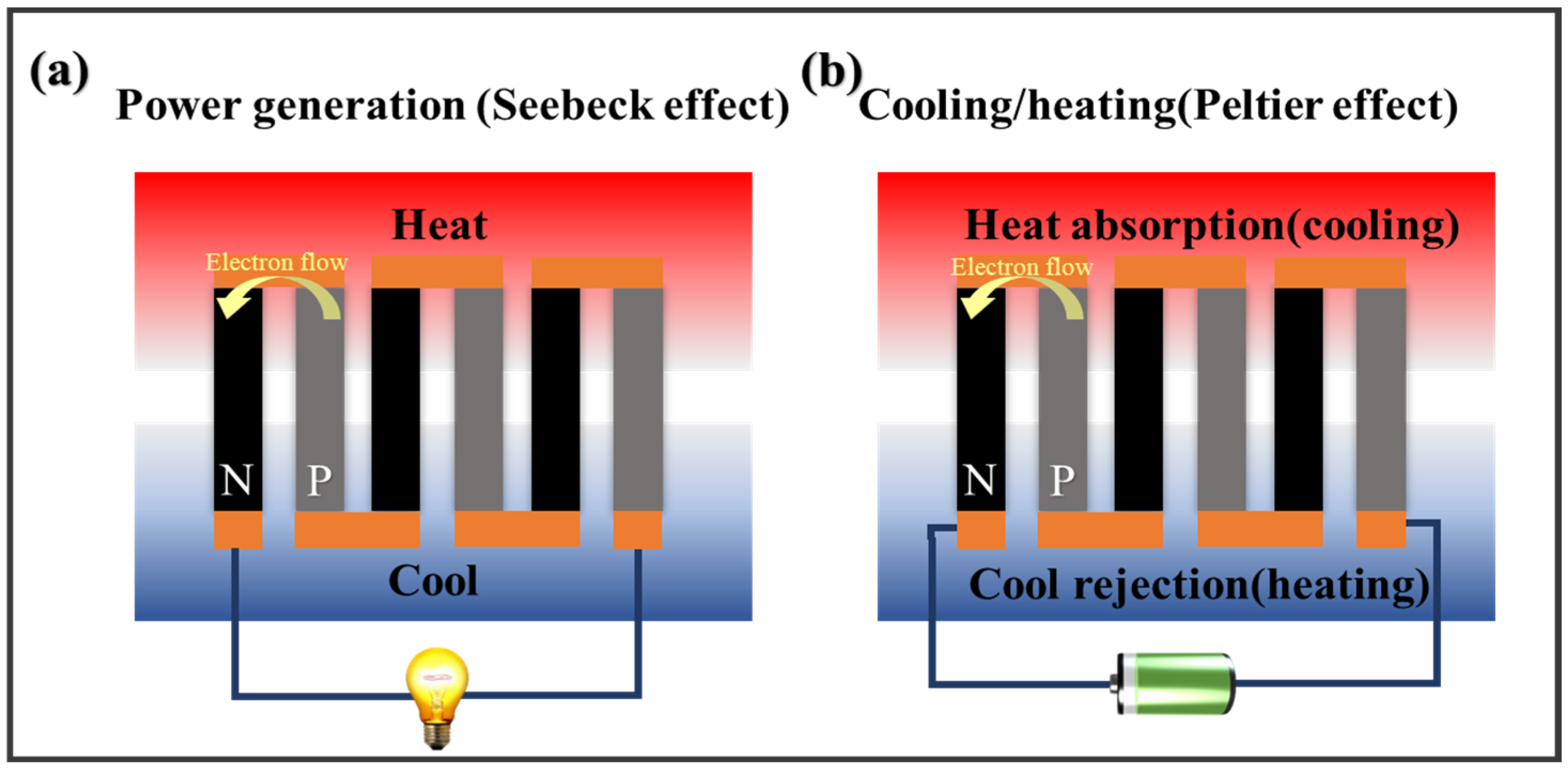

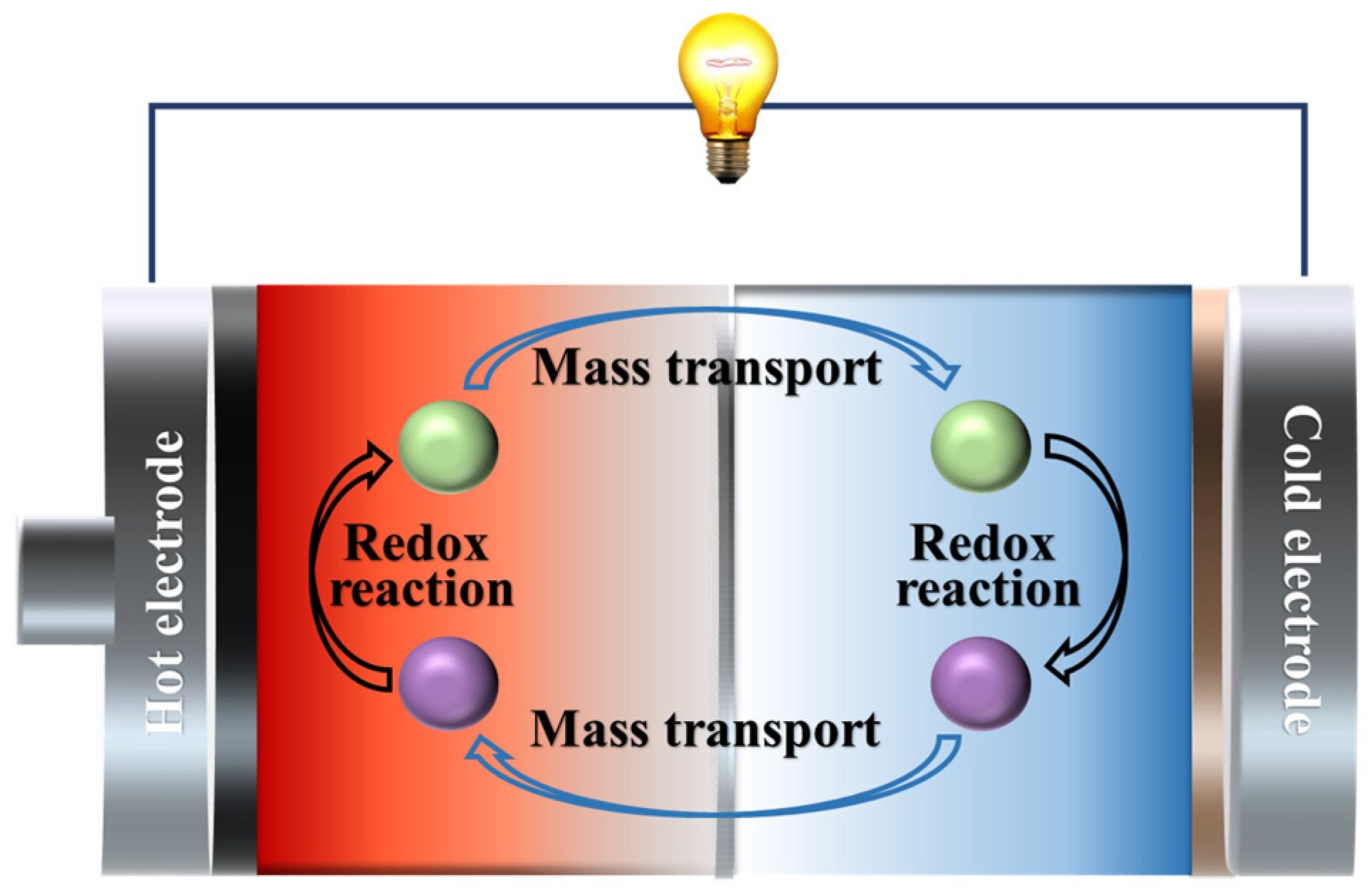
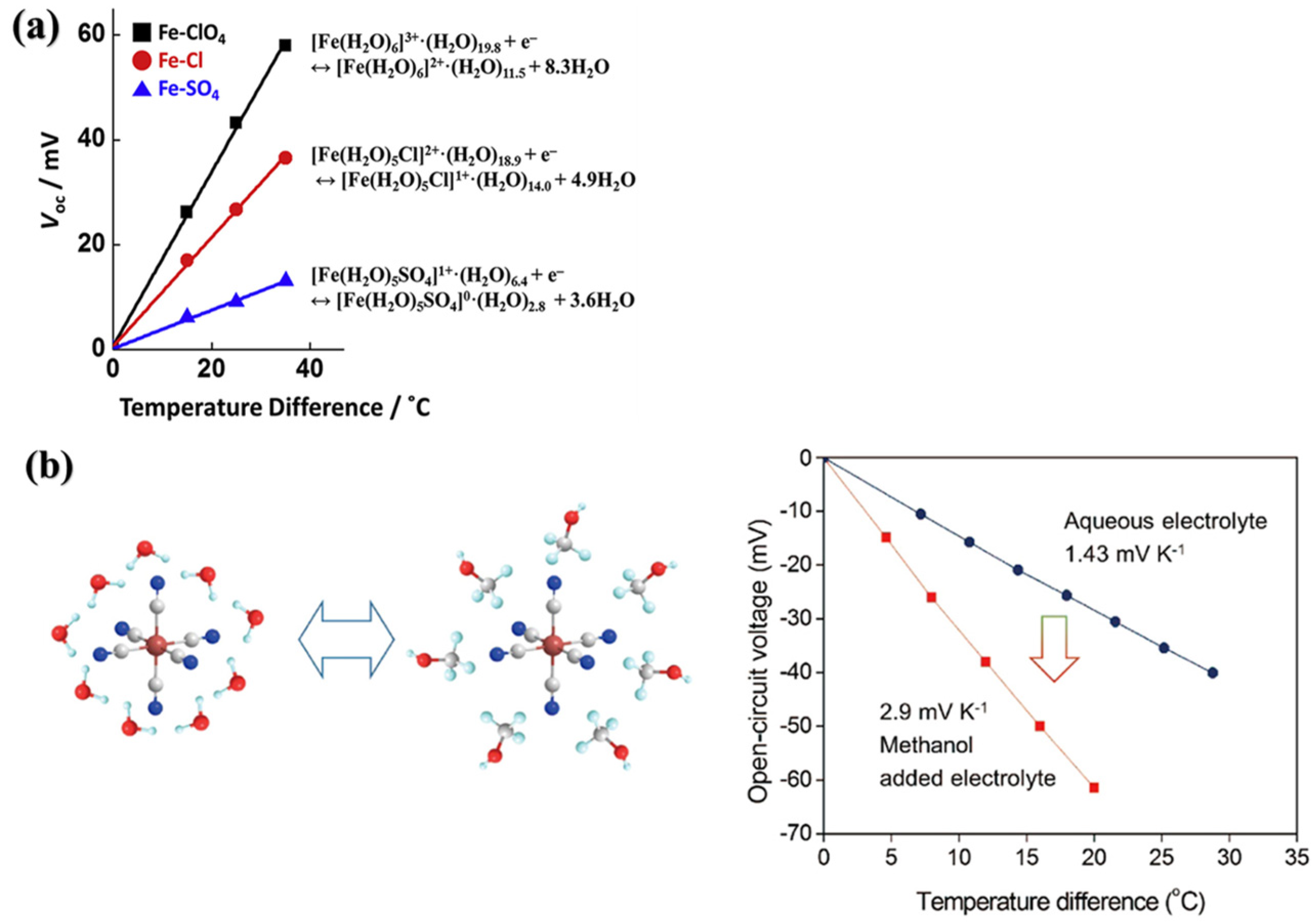
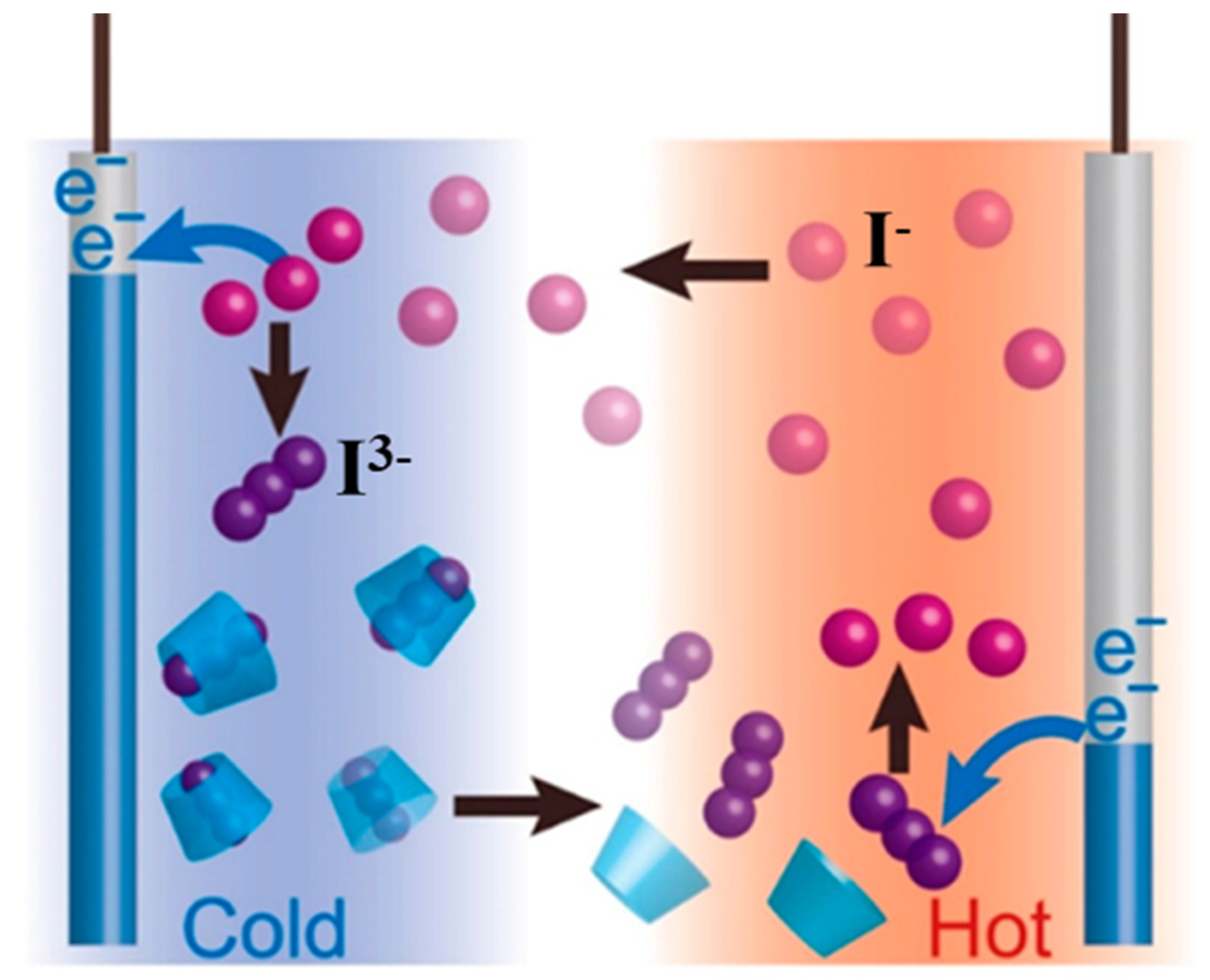
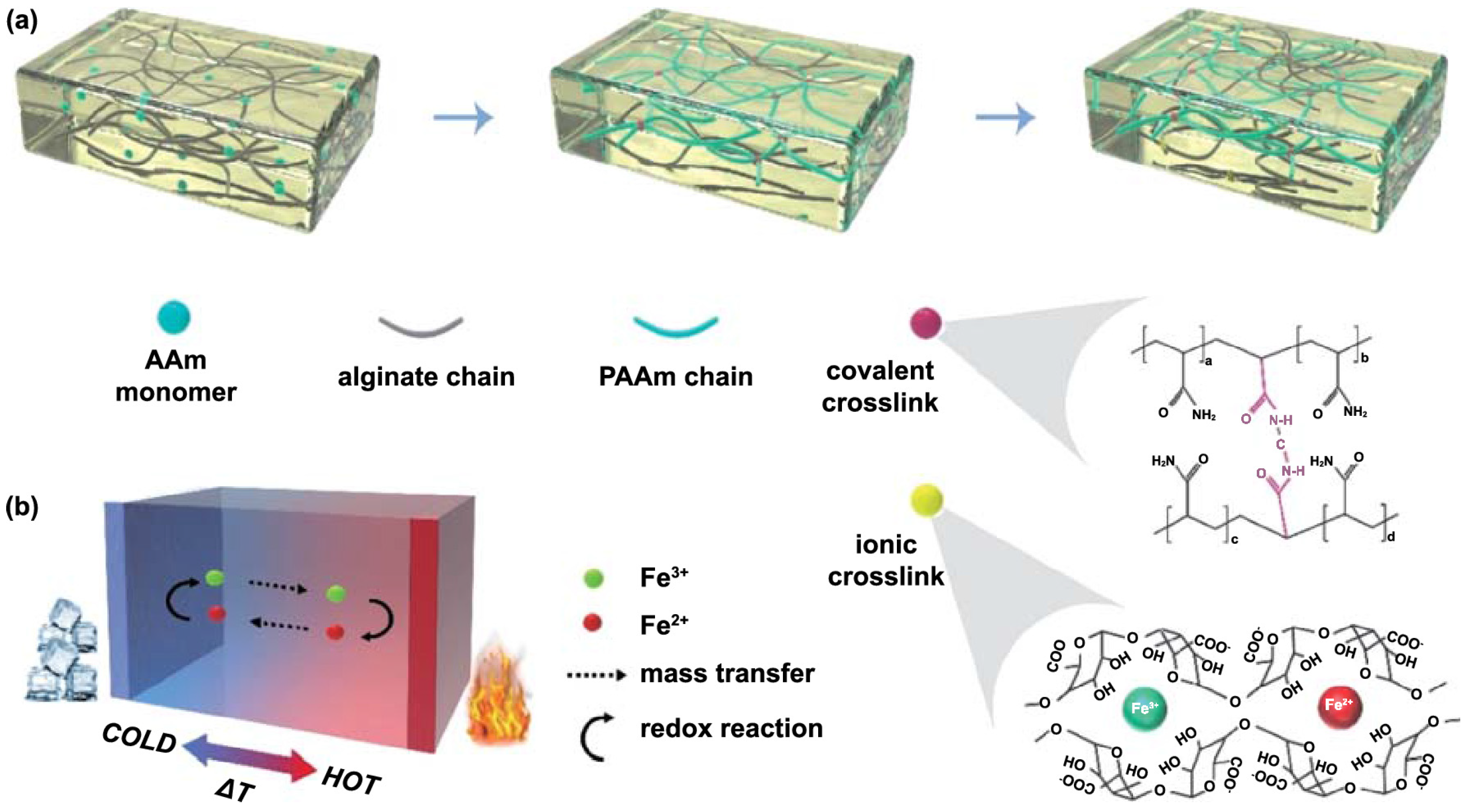

| Redox Couple | Matrix | Thermopower (mV K−1) |
|---|---|---|
| FeCN4−/3− | Gelatin | 17 (ΔT = 7 K) [51] |
| FeCN4−/3− | Cellulose | 14 (ΔT = 15 K) [46] |
| FeCN4−/3− | Poly(sodium acrylate) | −1.09 ± 0.04 (ΔT = 25 K) [48] |
| FeCN4−/3− | PVA | −1.21 (ΔT = 10 K) [47] |
| I−/I3− | N-isopropylacrylamide | −1.91 (ΔT= 10 K) [40] |
| [Co(bpy)3]2+/3+[NTf2−]2/3 | Poly(vinylidene fluoride-co-hexafluoropropene) (PVDF-HFP) | 1.56 ± 0.01 (ΔT = 15 K) [52] |
| Co(bpy)3]2+/3+[NTf2−]2/3 | Polyvinylidene difluoride and 3-methoxypropionitrile (PVDF-MPN) | 1.84 ± 0.01 [53] |
Disclaimer/Publisher’s Note: The statements, opinions and data contained in all publications are solely those of the individual author(s) and contributor(s) and not of MDPI and/or the editor(s). MDPI and/or the editor(s) disclaim responsibility for any injury to people or property resulting from any ideas, methods, instructions or products referred to in the content. |
© 2023 by the authors. Licensee MDPI, Basel, Switzerland. This article is an open access article distributed under the terms and conditions of the Creative Commons Attribution (CC BY) license (https://creativecommons.org/licenses/by/4.0/).
Share and Cite
Huo, B.; Kuang, F.; Guo, C.-Y. Design and Optimization Strategies for Flexible Quasi-Solid-State Thermo-Electrochemical Cells. Materials 2023, 16, 6574. https://doi.org/10.3390/ma16196574
Huo B, Kuang F, Guo C-Y. Design and Optimization Strategies for Flexible Quasi-Solid-State Thermo-Electrochemical Cells. Materials. 2023; 16(19):6574. https://doi.org/10.3390/ma16196574
Chicago/Turabian StyleHuo, Bingchen, Fengxia Kuang, and Cun-Yue Guo. 2023. "Design and Optimization Strategies for Flexible Quasi-Solid-State Thermo-Electrochemical Cells" Materials 16, no. 19: 6574. https://doi.org/10.3390/ma16196574
APA StyleHuo, B., Kuang, F., & Guo, C.-Y. (2023). Design and Optimization Strategies for Flexible Quasi-Solid-State Thermo-Electrochemical Cells. Materials, 16(19), 6574. https://doi.org/10.3390/ma16196574







